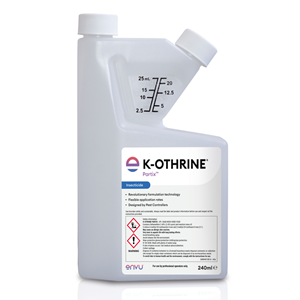Characteristics:
Two pairs of wings normally present; mouth parts piercing and sucking, forming a beak, or rostrum, normally held under the body. Metamorphosis usually incomplete, with egg and nymphal stages.
• Flat, oval insects, with very short, functionless forewings;
• Hindwings absent;
• Rostrum lies in a ventral groove;
• Tarsi 3-segmented;
• Exclusively bloodsucking
Species characteristics and host/habitat:
Common bed bug (Cimex lectularius)Adults, 5mm long; reddish-brown in colour, becoming purple after feeding; well-developed antennae; prominent, simple eyes; feet clawed so can climb rough but not smooth surfaces; ratio of head width (including eyes) to length of third antennal segment usually greater than 1.7.
The principal host is man, though other warmblooded animals can be parasitised. Found in human habitations throughout the world.
Other blood-feeding bugs
Blood-feeding bugs, very similar in appearance to the Common bed bug, can often be found infesting birds’ nests and bat roosts. In certain circumstances, these bugs may invade houses and attack humans. They include:
Pigeon Bug (Cimex columbarius)
Very similar in size and appearance to the Common bed bug; can be distinguished by the ratio of head width to length of third antennal segment, which is less than 1.6 in most specimens.
Principal hosts are birds; mainly found in starlings’ nests, pigeon lofts and poultry houses, but can attack man.
Martin Bug (Oeciacus hirundinis)
Similar in appearance to the Common bed bug, but smaller and more hairy. Can be further distinguished by the following characteristics:
when viewed from above, the front margin of the prothorax is far less concave than in the other species; the head width is also more than twice
the length of the third antennal segment.
Principal hosts are birds; often found in martins’ nests, but can attack man.
Areas where found:
As bed bugs cannot fly, they must either crawl or be passively transported in clothing, or more probably in luggage, furniture, books and other objects used as harbourages. Their ability to withstand many months without feeding increases their chances of surviving such transportation and the insects’ very wide distribution throughout the world demonstrates their success. Household’s, hotel’s etc. can be invaded by bed bugs, but it is likely that infestations will only become established in premises with low standards of hygiene. Bed bugs are often associated with poor, crowded and unhygienic conditions. Most bed bug infestations are to be found in
domestic premises, usually in the bedrooms. Both juveniles and adults live similar lives, hiding away in cracks and crevices for most of the time and coming out at night, usually just before dawn, to feed on the blood of their sleeping hosts. Their hiding-places will be close to where their hosts sleep: in the bed frame or the mattress, in furniture, behind the skirting, behind the wallpaper - anywhere that affords a dark harbourage during the daylight hours for these nocturnal creatures.
The insect infestations occur particularly in areas of high population density including hotels, hostels and holiday camps. In temperate climates bed bugs reach their peak numbers towards early autumn. At this time all stages in the lifecycle will be present. With the onset of colder weather their activity decreases, egg-laying ceases and development of the juvenile forms slows down. Bed bugs overwinter mainly as adults, since the eggs and nymphs are more susceptible to low temperatures and die out with the onset of winter, unless in adequately heated premises. The bird-feeding bugs, such as the Martin bug, will be found in the nests of their hosts and follow a similar lifestyle to the Common bed bug. The occasional problems of these species attacking humans are likely to stem from abandoned nests built near to or inside houses. Nests in lofts or under eaves would be a likely source if such an infestation were suspected.
Bed bugs are not regarded as disease carriers, but their blood feeding can cause severe irritation in some people, resulting in loss of sleep, lack of energy and listlessness, particularly in children. Iron deficiency in infants has resulted from excessive feeding by bed bugs. The bite often gives rise to a hard, whitish swelling which distinguishes it from the flea bite which leaves a dark red spot surrounded by a reddened area. Different individuals react differently to bites, some gaining immunity. Probably more important, however, is the distaste with which these insects are regarded. Bed bug excrement gives a characteristic speckled appearance to their harbourages, whilst their ‘stink glands’ confer a distinctive and unpleasant almond-like smell on infested rooms. In addition, the very thought of being preyed upon by such creatures is quite sufficient to make most people take immediate action to control them. The bed bug may even help to reduce living standards by
driving away householders with reasonable standards of hygiene, leaving behind only those who are less concerned with such matters. It is interesting to note that many factors are helping to sustain existing bed bug populations: modern building techniques, which allow easy access between adjoining properties; the increased use of central heating, which allows continued feeding and proliferation during winter; the movement of furniture in the second-hand market, which aids their distribution; all these serve to maintain population levels.
Lifecycle:
Bed bug eggs, which are slightly curved, measuring 0.8-1.3mm long by 0.4-0.6mm broad, are cemented to the surfaces of the harbourages, often in large numbers. Unhatched eggs are an opaque, pearly white colour, whilst hatched eggs, which remain in position long after hatching, are opalescent and translucent. While temperature and the availability of food have a profound effect on egg production, under optimal conditions egglaying is almost continuous, at a rate of about
three per day. The number of eggs laid by a female in the course of her adult life has been variously quoted as between 150 and 345. The first-stage nymphs which hatch from the eggs are just over 1mm long and, like all the nymphal stages, appear very similar to the adults, except in size and colour. Early instars tend to be more amber than the darker brown of the adult. Each nymph requires one full blood meal before moulting to the next stage. Though there are variations in size, due
mainly to the effects of feeding, which may increase the bug’s weight by up to 6 times, the approximate lengths of each of the five nymphal stages are: stage I 1.3mm, II 2.0mm, III 3.0mm, IV 3.7mm and V 5.0mm. The rudimentary wings appear in the last moult. The speed of development from egg to adult and the duration of adult life vary according to temperature and availability of food. With frequent feeding, at normal room temperatures (ca. 18-20°C) adults live for 9-18 months, with egg incubation taking 10-20 days and the complete cycle 9-18 weeks. Under these conditions nymphs feed at about 10-day intervals and the adults weekly. If necessary, both can survive long periods without food. Under cool conditions (13°C) starved adults could survive for as long as one year. In unheated rooms where the temperature drops below 13°C in the winter, egg laying, moulting and feeding stops and the population declines as eggs and young nymphs die. Under such conditions there is only one generation per year. Where temperatures do not fall so dramatically, breeding may continue throughout the year and
two generations can be attained.
Control:
In all infestations, particularly those newly established in well-kept houses, an attempt should be made to determine the source of infestation, so that proper measures can be taken. A thorough inspection of infested premises should also seek to uncover the extent of the infestation, since the measures necessary for
control will depend on whether the infestation is established and widely distributed throughout the premises, or recently introduced and likely to be more localised.
Control measures used must be thorough and be directed at all the harbourages. In circumstances where the infestation has originated from birds’ nests, it will be necessary to treat the nests and advisable to birdproof the building.
a) Hygiene/management
High standards of hygiene and house-keeping are unlikely to provide an adequate method of control, but will reveal the presence of bed bugs at an early stage, making control easier. Bed bugs can only proliferate if they are tolerated. If they are suspected, a close inspection of the bed, the mattress around the seams, the back of the headboard, etc., should reveal their presence. The use of a pyrethroid-based aerosol sprayed lightly around these areas may help, as the insects will
be driven out of their hiding places. The finding of eggs or egg cases and the blackish spots of bug excrement will also indicate their presence. Infested bedding (e.g. sheets) and clothing should be laundered or burnt and the fabric of infested rooms thoroughly cleaned. Particular attention should be paid to removing dust, fluff and debris from insect harbourages eg cracks, crevices, seams of fabrics, buttons on mattresses etc.
b) Insecticidal control
To eradicate the infestation it will be necessary to treat the premises thoroughly with suitable insecticides (see recommended products), including the beds, other furniture and harbourages in the fabric of infested rooms. A professional pest control organisation should be used, as the detection and thorough treatment of all bed bug hiding places is a job which requires experience.
_______________________________________________________________________________________________________________________
Glossary of terms:
Instars: Any stage in an insects life cycle, especially between moults.
Prothorax: First thoracic segment.
Rostrum: Beak or snout.
Tarsus (Tarsi): Apical section of leg (the foot).


